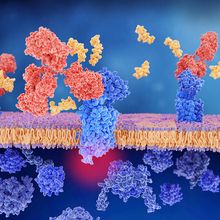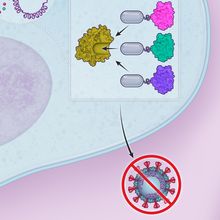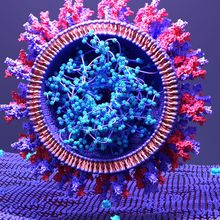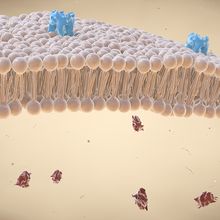Login
Subscribeprotein interactions

Simplifying the Search for Drug Targets
Aparna Nathan, PhD | Aug 1, 2023 | 3 min read
A new machine learning model promises fast prediction of drug-target interactions.

A Complete Guide to Label-Free Binding Analysis
Sartorius | Jul 27, 2022 | 1 min read
Discover how to select the most suitable platform to study biomolecule interactions depending on application and workflow needs.

Infographic: Short Protein Motifs’ Role in SARS-CoV-2 Infection
Conchita Fraguas Bringas and Jakob Nilsson | May 16, 2022 | 4 min read
Known as SLiMs, these stretches of up to 10 amino acids play notable roles in cell biology, including responses to viral invasion.

Viruses Target Super-Short Protein Motifs to Disrupt Host Biology
Conchita Fraguas Bringas and Jakob Nilsson | May 16, 2022 | 10+ min read
Only recently appreciated as critical components of cellular functions, unstructured stretches of amino acids called SLiMs are key to viral-host interactions.

Stress-Induced Molecular Globs Boost Bacterial Fitness
Ruth Williams | Oct 21, 2021 | 4 min read
Liquid conglomerations of molecules that form in bacterial cells in response to stress promote the cells’ survival, a study finds.

Understanding the Complexity of Cancer with Cryo-EM
The Scientist’s Creative Services Team and Thermo Fisher Scientific | Oct 12, 2021 | 1 min read
Explore how researchers use cryogenic electron microscopy (cryo-EM) to identify how mutations affect protein signaling and function through structural or conformational changes.

Technique Talk: Analyzing Molecular Interactions During Monoclonal Antibody Development
The Scientist Creative Services Team in collaboration with Sartorius Corporation | Mar 9, 2021 | 1 min read
In this workshop, you will learn how to measure protein interactions using Octet bio-layer interferometry.

Advancing Disease Research with Mass Spectrometry
The Scientist’s Creative Services Team | Sep 15, 2020 | 1 min read
Explore just how indispensible mass spectrometry is becoming to life science researchers.

The Dark Matter of the Human Proteome
Annie Rathore | Apr 1, 2019 | 10 min read
Advances in the functional characterization of newly discovered microproteins hint at diverse roles in health and disease.

Mass Spec Analysis of Protein Interactions
Jeffrey M. Perkel | Oct 1, 2016 | 7 min read
Using the technique to study how RNA, DNA, lipids, and small molecules interact with proteins
